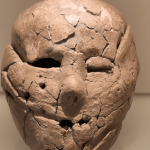 Mysteries
Mysteries  Mysteries
Mysteries  History
History 10 Surprising Stories About the Texas Rangers
 Humans
Humans 10 Philosophers Who Were Driven Mad by Their Own Theories
 Miscellaneous
Miscellaneous 10 Video-Game-Worthy Weapons and Armors from History
 Weird Stuff
Weird Stuff 10 Psychics Who Accurately Predicted Wartime Events
 The Arts
The Arts 10 Pieces of Art Inspired by a Broken Heart
 Health
Health 10 Science Fiction-Sounding New Medical Treatments
 History
History 10 Surprising Facts About the Father of Submarine Warfare
 Space
Space Ten Astonishing New Insights into Alien Worlds
 Weird Stuff
Weird Stuff 10 Bizarre Summer Solstice Rituals Still Practiced Today
 Mysteries
Mysteries Top 10 Haunting Facts About the Ghost Ship MV Alta
 History
History 10 Surprising Stories About the Texas Rangers
 Humans
Humans 10 Philosophers Who Were Driven Mad by Their Own Theories
Who's Behind Listverse?

Jamie Frater
Head Editor
Jamie founded Listverse due to an insatiable desire to share fascinating, obscure, and bizarre facts. He has been a guest speaker on numerous national radio and television stations and is a five time published author.
More About Us Miscellaneous
Miscellaneous 10 Video-Game-Worthy Weapons and Armors from History
 Weird Stuff
Weird Stuff 10 Psychics Who Accurately Predicted Wartime Events
 The Arts
The Arts 10 Pieces of Art Inspired by a Broken Heart
 Health
Health 10 Science Fiction-Sounding New Medical Treatments
 History
History 10 Surprising Facts About the Father of Submarine Warfare
 Space
Space Ten Astonishing New Insights into Alien Worlds
 Weird Stuff
Weird Stuff 10 Bizarre Summer Solstice Rituals Still Practiced Today
10 Strange Cases of Historical Remains Split Up after Death
When rich, powerful, and otherwise famous people die, they are often buried in elaborate tombs and shrines. They lived impactful public lives during their time on earth, and many want to memorialize them forever. In most cases, these high-profile grave markers become places of mourning and remembrance for thousands. In some cases, grief-stricken followers make pilgrimages to the final resting places of the world’s most powerful late leaders and popular public figures. For years or centuries after, the site of their hallowed remains is honored and cherished.
But not every death and burial goes so smoothly. In fact, more than a few historical public figures have suffered the indignity of inappropriate and unexpected burial events. In this list today, you’ll learn about ten famous public figures from history who didn’t experience the peace of a perfect resting place. In fact, (some of) their remains even vanished after death. Whether taken as morbid collectibles and keepsakes or simply lost to history, these ten tales tell of famous people who weren’t left intact upon entering the afterlife…
Related: Top 10 Curious And Creepy Mummified Remains
10 Anne Boleyn
Anne Boleyn lived an important life. She was the second wife of Henry VIII in the early 16th century. Among other notable things, she converted Henry to Protestantism after he sought a divorce from his first wife, Catherine of Aragon, and fought with the pope over it. But Anne Boleyn’s own future beyond the initial marriage wasn’t meant to be so bright.
After two miscarriages and allegations of infidelity, she was executed by Henry’s loyal court in 1536. Then, according to reports from the time, she was buried in the Chapel Royal near the Tower of London. Or is she?
Legend has long held that Anne Boleyn frequented a country estate called Erwarton Hall during her life. That’s where her aunt and uncle lived, apparently, and she was said to have fond memories of the place. As the story goes, her heart was said to have been separated from her body after her execution. Then, it was sent in a heart-shaped casket of its own to Erwarton, where it was supposedly buried within the estate’s crypt.
For the next 300 years, this rumor spread without much hard evidence. Then, in 1837, a mysterious heart-shaped casket resurfaced at the estate. It was reburied along with a special plaque claiming it was really the heart of the long-dead Protestant queen.
But is it really true? Well, maybe. The fate of Anne Boleyn’s corpse remains a mystery today. And the tale of her traveling heart isn’t even the only caper! In the 1840s, court reporters recorded another legend about Anne’s supposed final resting spot. In that one, her whole body was said to have been taken from London not long after her death to rest in the Norfolk-area village of Salle. Those were the ancestral homelands of Boleyn’s family, so the connection would seem to make sense.
But obviously, there’s no way to check today. And we’re pretty certain her heart can’t be in both Erwarton and Salle. But the legend has persisted either way. And every year, on May 19, Boleyn’s ghost is said to haunt the small village in recollection of her impactful life.[1]
9 Marilyn Monroe
Marilyn Monroe was one of the most iconic sex symbols of the 20th century. But when she died unexpectedly and abruptly in 1962, her fans were immediately taken aback. Many believed her passing wasn’t accidental. Many more believed she’d been killed for a host of outlandish reasons.
Some pointed to a supposed sexual connection to President John F. Kennedy and pondered whether American intelligence operatives had Monroe killed for homeland security reasons. In the months after her death, those rumors only got louder. Then, as the months turned to years, the conspiracy grew when Americans learned what happened to Marilyn’s remains.
A man named John Miner was the prosecutor in charge of investigating Marilyn’s death. After her autopsy, he published his own account of the situation in the Los Angeles Times. As was common practice at the time, Miner and the medical examiner, Dr. Thomas Noguchi, removed Monroe’s internal organs.
They sent her stomach contents and other organ samples off to a lab for analysis. They also took a series of blood and tissue smears for a deeper analysis. They sent those off to another site but were shocked to learn that the lab never received the samples. Concerned, Miner and Noguchi moved on to test some of Monroe’s other blood that they’d kept in the lab. In it, they found something interesting: the presence of Nembutal.
Nembutal, also known as pentobarbital sodium, is a barbiturate that works in the body as a sedative. It’s a depressant that can be used to treat insomnia. But Monroe didn’t have any needle marks anywhere on her body. Confused, Miner and Noguchi came to realize the drug must have been administered in an enema—but by whom? And why?
The medical experts never got the chance to learn that. Not only were Monroe’s tissue and blood samples lost in the mail, but her stomach and other organs were destroyed. Nobody is quite sure why they were wiped out. But with their destruction disappeared any hope of finding out more about the Nembutal. So the mystery of Marilyn Monroe’s death has persisted for six decades.[2]
8 St. Francis Xavier
The man who was destined to become St. Francis Xavier was born at the very beginning of the 16th century in modern-day Spain. As a young adult in 1542, he became part of a Jesuit mission assigned to a colony all the way in India. After preaching there for a while, he went on to Malaysia to save more souls.
Then, he became the priest to confirm the first Roman Catholic conversion in all of Japan when he convinced a man named Anjiro to accept God. But while his life in the church is interesting from a missionary perspective—and certainly unique in her era as far as world travel is concerned—St. Francis Xavier’s life got really interesting after his death.
Following his missionary success in Japan, St. Francis was set to travel to China for more. But he died just before the trip. At first, he was buried in a simple casket and shipped all the way back to India. But two months after he was laid to rest there, church parishioners supposedly discovered that his entire body was still intact.
They had covered his corpse with lime in order to quickly dissolve the flesh. But by remaining intact, this was supposed to prove Francis was indeed a saint. To prove his body’s saintly provenance, Portuguese church officials in India displayed Francis’s body in a church building in the city of Goa. He was deemed a saint and heralded the world over.
That’s probably how the story of St. Francis Xavier should have ended, but there was still more to come. In 1554, while his body was on display, a Portuguese noblewoman named Dona Isabel Carom reportedly bit the toe off the corpse! Then, of course, she took it home with her as a souvenir. Amazingly, legend has it the toe stayed in her family for decades and then centuries. By 2009, her descendants even made their possession of it public once more.
As for St. Francis Xavier, most of the rest of his body continues to reside in the Basilica of Born Jesus in Goa. But over the years, body parts have been hacked off and sent around the world too. In 1614, parts of his right arm were sent to Macau, Malaysia, and Rome. Then, his hands were shipped to Japan in honor of his work there. Today, St. Francis Xavier is both venerated and continues to be worshiped worldwide—in pieces.[3]
7 John the Baptist
The story of John the Baptist is one of the best-known tales of the Bible. In the Gospel of Matthew, we learn John—the precursor to Jesus in the New Testament—had rebuked Herod Antipas for marrying his brother’s wife. Enraged at John, Herod threw him into prison. And once there, Herod chose to behead John to please his niece.
Then, Herod literally served the head to the woman on a platter. From there, John’s body was buried headless. But as you might have figured by now, that wasn’t the end of that. In fact, even today, Christian followers and Biblical scholars still debate the final resting place of John’s head.
According to tradition, John’s head was supposedly sent to the cathedral in Amiens, France. But that’s not the only final destination for it. The Basilica of San Silvestro in Rome also asserts they have the prophet’s head.
At one point, a Bavarian collector of old-world relics named Duke Wilhelm V was purported to have taken possession of it to display in Munich’s Residenz Museum. And the Umayyad Mosque in Damascus, Syria, which was a Catholic basilica dedicated to worshiping John the Baptist before the Islamic sweep across the region, has also claimed ownership.
Obviously, John the Baptist’s head can’t be in all four locations. So which one is it? Or could it have been buried in another spot altogether? In 2010, excavators working at the Bulgarian ruins of the Sveti Ivan Monastery uncovered the remains of a man. They carbon dated the body, which came back to the first century, with Middle Eastern DNA in its profile.
Archaeologists were shocked and began to wonder if that was the true location of John the Baptist’s actual remains. Of course, there’s no way to be certain of any of this today. And the mystery will continue to move on with time.[4]
6 Buddha
Buddhist tradition holds that the Buddha was cremated after his death. But apparently, the entirety of his corpse wasn’t incinerated in the fire. Immediately after his passing and cremation, loyal followers were said to have recovered four teeth and three small bones from the ashes. Immediately, the teeth and small bones were stored away securely and kept for safekeeping.
Then, Buddhists the world over created shrines venerating the items and using them to worship the religion’s founding father. As the legend goes, one of the teeth was supposedly given to the King of Kalinga, a region now on the eastern coast of India. That tooth was later transferred to the Kingdom of Ceylon in what is now Sri Lanka. That island’s king was a devout Buddhist at the time, so he gladly took the tooth and carefully locked it away to ensure its security.
Or maybe he wasn’t so careful after all. Over the next few hundred years, the Buddha’s tooth was stolen out of Ceylon multiple different times. In one instance, Portuguese officials swiped the tooth with the intent to destroy it. They wanted to wipe out Buddhist artifacts and cultural items and push Christianity as the main religion in the area.
Alarmed leaders of the Pegu Kingdom in Burma offered to ransom the artifact, but it was of no use. A local activist Catholic bishop ordered the tooth ground down into a fine powder and burned. Then, he tossed it into the river to keep it from becoming a symbol of inter-religious warfare in Southeast Asia.
The rest of Buddha’s remaining teeth and bones dispersed throughout time and were lost to the annals of history—except for one. Today, the tale of the Portuguese tooth fight isn’t the only Buddha tooth supposedly still out there. Monks at the Temple of the Sacred Tooth in Kandy, Sri Lanka, continue to celebrate Buddha’s so-called dental remains even in the modern age. They wash it with scented water every Wednesday. They also perform exaltations upon it three times daily. Whether or not you believe that’s really Buddha’s tooth, it doesn’t matter much—because they certainly do.[5]
5 Geronimo
Geronimo was a leader of the Apache Nation best known for his fierce resistance to American and Mexican expansion into his tribe’s territory. He fought viciously against both American and Mexican soldiers throughout his life. But when he died in 1909, it was in a prison at Fort Sill, Oklahoma, where he’d been sent by the American government 14 years earlier. Today, he is buried at Beef Creek Apache Cemetery in Oklahoma’s Comanche County. Well, most of him, that is.
As legend would have it, less than a decade after Geronimo was buried, his body was supposedly dismembered by Yale University’s Skull and Bones secret society. Some said the grave robbing was done under the direction of Prescott Bush—the father of President George H.W. Bush and the grandfather of President George W. Bush. According to reports from the time, Prescott supposedly went to rural Oklahoma during a long school break and dug up the bones. Then, he allegedly brought them back to the Skull and Bones’s headquarters, aptly named “The Tomb.”
For what it’s worth, a letter recently discovered in Yale’s Sterling Memorial Library does seem to confirm that, at the very least, these rumors about Prescott were being flung around campus at the time. Whether he actually stole Geronimo’s body or not, other Yale secret society members wrote to each other about the supposed plot.
Today, many people involved with Yale have denied the story. But Geronimo’s own great-grandson isn’t so sure. He has offered up his own DNA to be tested against bones in Yale’s museum collections to see if the Ivy League university really does have Geronimo on campus.
For now, Yale reps continue to deny the bones are in their possession. Besides, university officials note that the Skull and Bones chapter has now had more than 100 years to move the bones if they ever did have them in the first place. The caper makes for a fascinating mystery, though. And as far as Geronimo’s great-grandson is concerned, if the bones really are there, he wants them returned so descendants can bury their ancestor on the Apache’s ancestral homeland in the Arizona desert.[6]
4 Napoleon
Napoleon Bonaparte’s life came to a less-than-ideal end after he was defeated in battle at Waterloo. In response to his devastating loss, the reigning British shipped him off to the remote Atlantic island of St. Helena to live out the rest of his life. It was there in 1821 that he died, mostly alone and irrelevant.
At first, his remains were even buried right there on the island. Then, 19 years later, they were transferred to France based on the order of King Louis-Philippe I. But when French officials went to the island to dig up the remains and bring them back to Napoleon’s homeland, they were in for the surprise of a lifetime: the dead man’s penis was missing!
French officials began to dig around at what could have happened and learned something interesting. Upon Napoleon’s death, his doctor, Francesco Antommarchi, cut out all of the emperor’s organs. That was pretty typical when it came to embalming monarchs and important figures at the time. So the French weren’t thrown by the organ removal. But for some reason, Antommarchi apparently cut off the former emperor’s manhood too.
As it turned out, the Italian doctor handed the organ to a priest, who then brought it back to Napoleon’s native land of Corsica. But the priest was killed soon after returning home. He passed the penis down through his family, but it stayed in anonymity for a century. For decades, Napoleon’s biographers, historical researchers, and French officials all thought the penis was gone forever. Then, a hundred years later, came a surprise.
By 1916, the penis somehow ended up in a British collector’s personal items. He decided it was time to ship it around and put it on display. In 1927, for example, it was presented as part of a “Relics of Napoleon” collection at the Museum of French Art in New York City. From there, ownership of the penis was somehow transferred to noted urologist John Lattimer.
When Lattimer died, he passed the appendage down to his own daughter. She reportedly still owns it today but has chosen to keep the collection to herself. The French government hasn’t asked for it back or anything, so it seems the penis may be kept private for the time being. It’s a strange end to a bizarre saga—but this outcome is certainly better than that century-long period from before where it had vanished altogether![7]
3 St. Anthony of Padua
Anthony of Padua was a Portuguese priest in the Franciscan tradition. He lived during the 12th and 13th centuries, and when he died in 1231, he was feted as one of the great preachers of his time. In fact, he was so popular that he almost immediately became a saint upon his death. Pope Leo XIII noted his worldwide popularity and quickly canonized him.
To accommodate the growing procession following St. Anthony’s death, his body was then moved to a large cathedral. Pilgrims from all over the world came to visit. Upon their arrival, his body was exhumed and examined by church officials.
It was then that they supposedly discovered something interesting: Virtually all of St. Anthony’s body had decomposed except for his tongue and jaw. The man who had been such a virulent and expressive public preacher in his time alive had apparently left his so-called speaking tools to remain with the Church after his death. His tongue was even said to give off a “shining” aura suggesting true sainthood.
Pilgrims got the message quickly and completely: Anthony of Padua was one of the best preachers in all of Catholic history, and it was the right thing to do to remember him as such.
Ever since then, St. Anthony’s tongue and jawbone have been separated from his body and held in high esteem by the church. They have been displayed most of the time in a special case at the Basilica del Santo in the city of Padua, where Anthony was from. But the items have also taken several trips around the world too.
In 2013, for example, the magic tongue traveled with Catholic officials across Europe and North America to visit Catholics from various countries celebrating the 750th anniversary of St. Anthony’s death.[8]
2 Galileo Galilei
Galileo Galilei remains one of the world’s foremost thinkers even now. And he was certainly one of the smartest men of his day. The Italian-born mathematician and scientist promoted and developed Nicolaus Copernicus’s idea that the Earth revolves around the sun. And while he paid a price for the then-controversial idea during his life, after death, Galileo has been remembered as a scientific pioneer.
Still, when he died in 1642, his passing went off without much public notice or mourning. He was buried in a simple grave at the Novitiate Chapel at Florence’s Basilica of Santa Croce. For nearly 100 years, he lay in that tiny side chapel yard in relative anonymity, even as his contributions to science swept the globe. Then, in 1737, a Florentine Duke named Gian Gastone de’ Medici decided Galileo needed a more proper burial spot.
Along with other admirers, de’ Medici moved the body to the chapel’s north yard. In his new digs, Galileo was laid to rest across from Michelangelo. Clerics complained about giving the heretic this prominent burial position, but de’ Medici didn’t back down. Even today, Galileo’s remains continue to rest in that spot.
But not all of his remains are there. As his body was being moved, somebody snipped off two of Galileo’s fingers, a thumb, a few of his vertebrae, and one of his teeth. The vertebrae ended up being housed by the University of Padua, thankfully. The rest were passed down among one single Italian family for nearly two full centuries. But then, in the early 20th century, things started to get tricky.
By 1905, the fingers and tooth had reportedly disappeared. They resurfaced at an auction nearly 100 years later. Eagle-eyed archaeologists knew exactly what the items were even if the original descriptions declaring their provenance had been lost to time. Thankfully, a wise donor purchased the fingers and tooth and promptly returned them to the Museum of the History of Science in Florence. Today, they are now proudly (and safely!) held in the museum’s collection.[1]
1 Adolf Hitler
The end came suddenly and violently for Adolf Hitler in 1945. American soldiers were closing in on the dying remnants of Nazi Germany following a long, terrible fight in World War II. Sensing that the end was near, Hitler chose to shoot himself and his wife, Eva Braun, rather than face justice. Knowing how coveted his body would have been by both American and Soviet soldiers invading Berlin, German officials were forced to take action.
They burned the bodies and stole the cremated ashes to prevent them from falling into enemy hands. But several of Hitler’s bones survived the cremation. And while some of those bones were hidden away and locked up, others somehow got out of German containment. Specifically, Hitler’s jawbone and part of his skull were both lost to history right after his 1945 suicide. Then, thirty years later, they suddenly turned up once more.
The skull and jawbone had been kept at the Magdeburg Garrison in East Germany for a while. But when the USSR took over the region and began the Cold War, the remains were stolen away to Russia. For years, the Russian intelligence agency FSB denied possessing the bones. Conspiracy theories ran rampant about what supposedly happened to Hitler’s remains. Finally, in 2009, the FSB admitted to owning the bone fragments in question, as well as some of Hitler’s teeth.
Then, in 2018, Russia let a team of scientists study the bones to determine their identity. With small fragments of 70-year-old bones, there was only so much the researchers could do. But the teeth were able to be positively matched to a description Hitler’s long-ago dentist had given regarding the dictator’s dental records. It wasn’t much, but it was enough to allow the scientists to conclude one thing: the bone fragments appeared to be genuine, and Hitler really did die in 1945, as the world was told.[10]








